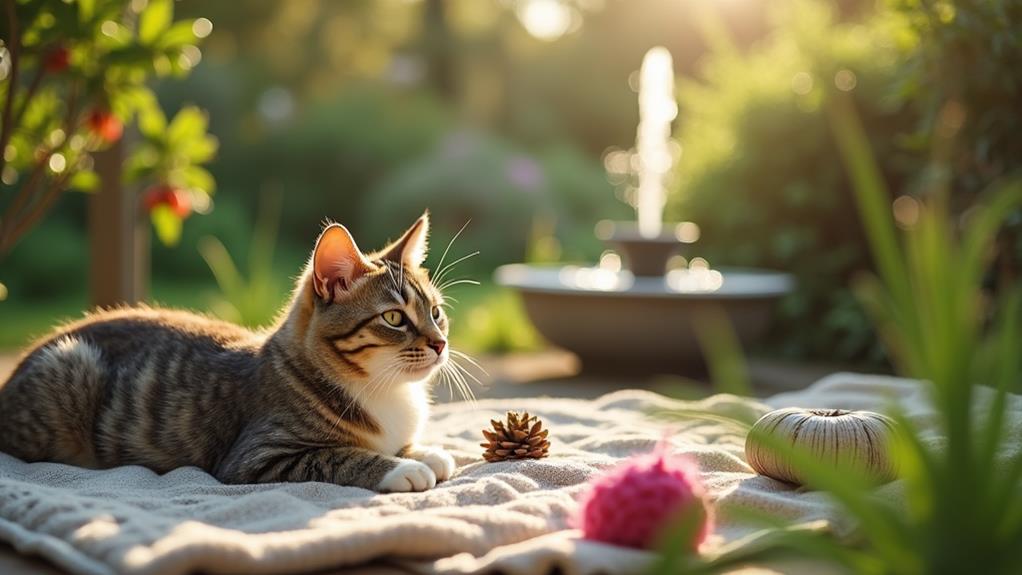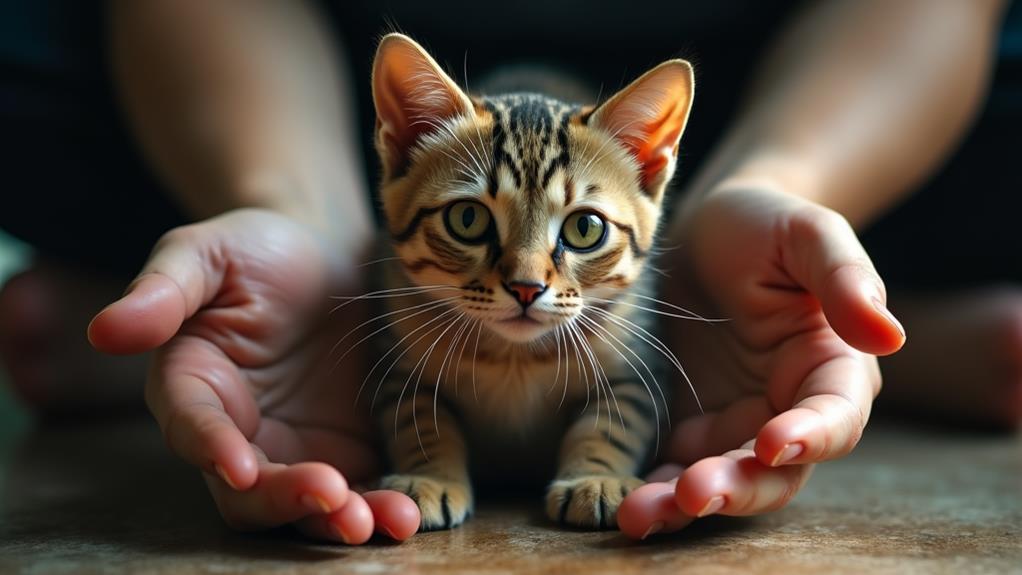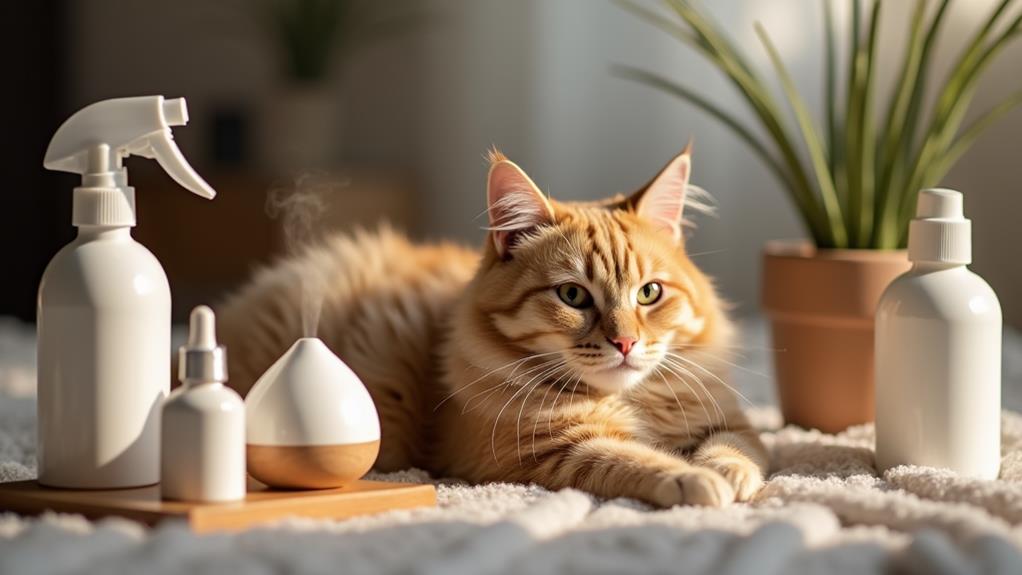How to Calm a Feral Cat: Techniques for Reducing Stress

To calm a feral cat and reduce its stress, create a quiet, enclosed sanctuary with familiar items to foster security. Establish a predictable routine for feeding and care, and provide cozy hiding spots. Allow the cat to investigate at its own pace and offer treats to encourage positive interactions. Use a calm voice and respect its boundaries. Recognize fearful signals like hissing or trembling, and utilize calming products like Feliway or Thundershirts. Minimize stress with gentle handling and soothing music. By focusing on these techniques, you'll cultivate trust and improve your relationship. Delve deeper to uncover more tips and strategies.
Understanding Feral Cat Behavior
Understanding feral cat behavior begins with recognizing their strong survival instincts. Feral cats often exhibit assertive behaviors, reacting sharply to perceived threats. This heightened state of alertness stems from their need to navigate a world filled with potential dangers. Each cat's behavior varies; some feral cats might be more sociable and open to human interaction, while others remain distant and wary. These individual personalities can influence how they respond to stress and anxiety in their environment.
Environmental stressors like loud noises and unfamiliar scents play a significant role in shaping feral cat behavior. Such disruptions can increase a cat's anxiety, causing them to display fear responses like hiding or aggression. Health challenges, including dental disease and blindness, further impact their behavior, often exacerbating stress levels.
Socialization is vital for calming feral cats. You'll need patience and time, as successful socialization requires gradual acclimatization to human presence. It's a slow process but necessary for reducing stress and anxiety. By understanding these factors, you can better appreciate the complex behaviors of feral cats and work towards creating a more harmonious interaction with them, ultimately helping them feel more secure and less anxious.
Creating a Safe Environment
Why is creating a safe environment so important for calming a feral cat? It's significant because a feral cat often feels threatened in new surroundings, and establishing a safe space can greatly reduce stress. Start by designating a quiet, enclosed area in your home as the cat's sanctuary. This calming environment will help them feel secure and minimize anxiety. Incorporate familiar items from their previous location, like bedding or toys, as these can provide comfort and make the change smoother.
Next, focus on developing a predictable routine. Consistency in feeding and care fosters a sense of stability, which is essential for a feral cat adjusting to a new space. A structured schedule allows the cat to anticipate what comes next, reducing stress over time.
To improve their sense of safety, provide cozy hiding spots. Boxes or covered beds are excellent options, offering the cat a secure retreat where they can relax and feel protected. Moreover, minimize overwhelming scents and avoid cleaning disruptions in their area to maintain a calming environment.
Here's a quick guide to creating a safe environment:
- Designate a quiet, enclosed space with familiar items.
- Establish a predictable routine for feeding and care.
- Offer cozy hiding spots for extra security.
Gradual Interaction Techniques

After establishing a safe environment, the next step involves interacting with the feral cat in a manner that feels natural and non-threatening to them. Gradually introduce yourself by allowing the cat to investigate its surroundings at its own pace. This helps reduce the likelihood of the cat feeling overwhelmed or stressed. Begin your interactions by gently offering treats. This encourages the cat to come closer, associating your presence with something positive. Always use a calm and soothing voice; it'll help keep your cat feeling safe and secure during these early encounters.
It's essential to let the cat dictate the pace of your interactions. If the cat shows signs of being stressed, such as hissing or retreating, give it space. Respecting its boundaries is key to building trust. Engage in short, low-pressure interactions regularly. This approach helps keep your cat from feeling overwhelmed and makes future handling techniques more manageable. Remember, the goal is to build trust and comfort gradually. By consistently using these techniques, you'll create a foundation for positive reinforcement, making it easier for the cat to adjust and allowing for more advanced handling techniques in the future.
Positive Reinforcement Strategies
To effectively calm a feral cat, positive reinforcement strategies are vital. Using treats or favorite toys as rewards can markedly reduce a cat's stress and anxiety. This method helps your cat associate human interaction with positive experiences, encouraging trust and cooperation. However, it's significant to keep in mind that every cat is different, so be prepared for some trial and error as you find what works best for your feline friend.
Here's how you can employ positive reinforcement:
- Gradually Increase Interactions: Start with short interactions, offering rewards for calm behavior. As your cat becomes more comfortable, slowly increase the duration and intensity of these sessions.
- Be Patient and Generous with Rewards: Consistently rewarding even the smallest steps toward trust-building reinforces positive experiences. This patience helps reduce your cat's stress and fosters a more trusting relationship.
- Focus on Calm Behavior: Recognize and reward moments when your cat is calm and relaxed. This approach improves their confidence and willingness to engage with you.
Understanding that your cat might feel stressed due to instinctual survival responses is fundamental. By adapting your strategies and focusing on positive reinforcement, you're more likely to help your cat develop a secure and trusting bond over time.
Recognizing Fearful Signals

Recognizing fearful signals in feral cats is essential for ensuring their comfort and safety. When you're around feral cats, pay close attention to their body language. Fearful signals often include hissing, growling, and dilated pupils, all of which indicate a heightened state of stress or feeling threatened. Subtle cues like flattened ears, tail flicking, and avoiding eye contact are key indicators of anxiety.
Vocalizations can also tell you a lot. If a feral cat is howling or excessively meowing, it's likely feeling threatened or anxious in its environment. Physical signs of fear, such as trembling, rapid breathing, and fur standing on end, serve as clear warnings. These behaviors suggest the cat is not comfortable and may react defensively.
Low-Stress Handling Methods
Understanding a feral cat's fearful signals sets the stage for employing low-stress handling methods that assure both you and the cat remain safe. Recognizing body language cues like flattened ears or hissing allows you to adjust your approach and reduce stress. Always prioritize a calm environment by minimizing direct eye contact and using slow movements and soft voices. These actions help the cat feel more secure and less threatened.
To guarantee safe handling, consider creating a towel sanctuary. Spray a large towel with Feliway and gently cover the cat, wrapping it securely. This technique reduces stress and prevents sudden movements that may frighten the cat. Moreover, handling gloves can enhance your confidence. Before attempting to handle a feral cat, practice the technique on a friendly cat to familiarize yourself with the process.
Here are three key steps for low-stress handling:
- Create a Towel Sanctuary: Use Feliway on a towel to calm and secure the cat.
- Wear Handling Gloves: Practice with a friendly cat to build confidence.
- Use Gentle Techniques: Support the entire body without pressure on sensitive areas.
Utilizing Calming Products

Amidst the challenge of calming a feral cat, utilizing calming products can be a game-changer. Feliway, a synthetic pheromone product, works wonders by creating an environment that mimics the safety and comfort of natural facial pheromones. This can greatly reduce anxiety levels in feral cats. Compression wraps, like Thundershirts, provide gentle pressure that promotes a sense of security, helping to alleviate stress.
Music can also play a soothing role. Soothing playlists specifically designed for our feline friends have been proven to lower stress and encourage relaxation, especially during handling or recovery times. It's a simple yet effective method to calm a cat's nerves.
Supplements are another useful tool. Products like Zylkene, derived from milk proteins, help ease anxiety without sedation, promoting a relaxed state that's safe and natural. Calming treats, infused with ingredients like L-theanine and chamomile, offer immediate relief and can help create positive associations during stressful situations. These treats are not just tasty; they're also an effective strategy in reducing a cat's anxiety. By utilizing these calming products, you can create a more peaceful environment and improve the well-being of your feral cat.




